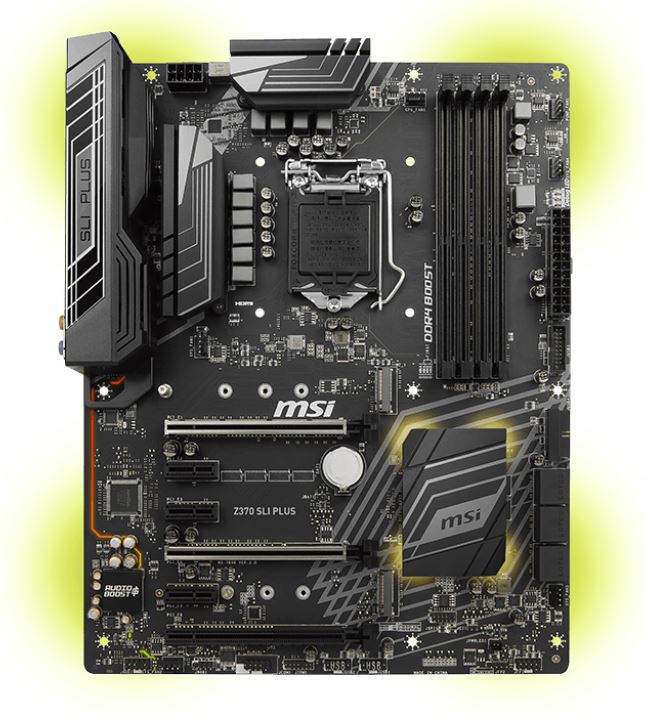Analyzing Z370 for Intel's 8th Generation Coffee Lake: A Quick Look at 50+ Motherboards
by Ian Cutress, Anton Shilov, Joe Shields & Gavin Bonshor on October 20, 2017 2:00 PM ESTMSI Z370 SLI Plus
The MSI Z370 SLI Plus sits as the next installment on a very successful SLI Plus line from MSI. On some chipsets, the SLI Plus sits as one of the cheapest boards that still boasts extra features, with the key one being SLI but also going full-bore with the MSI software stack. Compared to some of the other Z370 'Pro' series boards, this board has multiple PCIe slots using reinforcement, shrouding on the back panel IO, a higher phase count power delivery, and uses the latest Realtek ALC1220 audio codec.
The SLI Plus’ appearance isn’t much different than some of the other mid-level boards MSI is releasing for Z370. It is a black on black theme, with on-PCB stencil design elements around the chipset, chipset heatsink, and power delivery. There are two heatsinks to keep the power delivery cool, although they are not heatpiped together. RGB LEDs are found under the chipset heatsink, as well as on the back of the board and in the audio separation line. There is one RGB header on the board for adding another RGB LED strip.
The four memory slots are not strengthened on the SLI Plus, but use single sided clips to allow for easy installation when other large GPUs are present. The board supports up to 64GB of memory, with speeds up to DDR4-4000+. The top two full-length PCIe slots are powered by the CPU in an x16 or x8/x8 configuration, and use MSI's structural reinforcement. The third full-length PCIe slot is from the chipset and does not have reinforcement.
Like almost every board in the roundup so far, the SLI Plus has six SATA ports supporting RAID 0, 1, 5, and 10. Additionally, there are two M.2 slots, with one found above the top PCIe slot and a second between the last two full-length slots. The top M.2 location can fit up to 110mm drives while the bottom supports up to 80mm.
A total of six 4-pin hybrid controlled (PWM/voltage) fan headers can also be found, with four around the socket and two towards the bottom of the board. The Realtek ALC1220 codec is used for audio, featuring an EMI shield and PCB separation. Networking duties are handled by the Intel I219-V controller.
The rear panel has two USB 3.1 (10 Gbps) ports, one Type-A and Type-C, handled by the ASMedia ASM3142 controller. Users will get four USB 3.1 (5 Gbps) ports and two USB 2.0 ports on the rear panel also, with two headers from each for front panel connectors. The rest of the rear panel contains a combination PS/2 port, DVI-D and HDMI for video outputs, the Intel network port, and audio jacks with SDPIF.













83 Comments
View All Comments
weevilone - Wednesday, October 25, 2017 - link
Notable that though the new boards are often very similar to their Z270 predecessors, Asus has dropped Thunderbolt 3 support from the Maximus X Hero board.masouth - Thursday, October 26, 2017 - link
ASUS ROG Z370 Maximus X Hero"....new metallic heat sinks that are an upgrade over the plastic heatsinks found on the Z270 version"
Please excuse my ignorance because I didn't own a ROG Z270 mb but...plastic HEAT SINKS? Not shrouds or decoration over a heat sink but the actual heat sinks themselves? That's either wrong, they performed their job pretty poorly, or plastic resins have advanced a lot farther in thermal conductivity (and cost for such) than I realized.
flowrush - Sunday, November 19, 2017 - link
"The other main distinguishable feature is the inclusion of integrated 802.11ac Wi-Fi with an antenna (that can only be described as a shark fin) found on the F."The above is incorrect in the article. The integrated Wi-Fi module with antenna is found on the E not the F.
Coldgame - Saturday, November 25, 2017 - link
I'm looking to build a rig with the Z370 Gaming ITX/ac, a GTX-1070 card and an Apple Thunderbolt Display.The review states:
"The key difference in the support between the two boards is going to be the Thunderbolt 3 port on the Gaming-ITX. This port supports video outputs..."
So, can anyone confirm or deny that video generated by the GTX-1070 can be output through the onboard Thunderbolt 3 port?
hanselltc - Sunday, December 3, 2017 - link
Looking forward to low-middle end mITX choices from this platform. It'll probably be paired with a 8100/8300 and be my secondary machine.Roen - Sunday, February 4, 2018 - link
Where are the 10 Gbps ports on the back? They all look like 5 Gbps ports, even the Type C.rbarak - Wednesday, February 21, 2018 - link
Is anyone using the Z370-P on Linux with two screens?I built a new machine based on the Z370-P, and both the DVI and the HDMI connected screens show the same image, and the RHEL7 setup/displays show only one Unknown Display.
I follwed the advice on stackexchange, and added this line:
$ grep GRUB_CMDLINE_LINE_DEFAULT /etc/default/grub
GRUB_CMDLINE_LINE_DEFAULT="i915.alpha_support=1"
Then I did:
sudo grub2-mkconfig -o "$(readlink /etc/grub2.conf)"
And rebooted, but still, the two displays are not shown.
dromoxen - Wednesday, May 9, 2018 - link
Shocked to see that both the Asrock mitx boards are "szie=ATX" .. LOLThe addition of Tunderbolt sure seems to add a hefty premium £120 vs £160 , luckily I can do without.
Kroebo - Sunday, October 7, 2018 - link
Sadly, I discovered that the ZUG Gaming PLUS doesn't support SLI.trag - Tuesday, January 15, 2019 - link
On the ASrock Z370M Pro4 the M.2 slot information is backwards. Both slots support NVME. One slot also supports SATA. As written, "The first M.2 slot is SATA only while the second supports PCIe." it seems to say that one slot is SATA only and the other slot is PCIe (NVME) only.